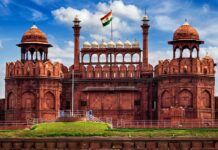[vc_row][vc_column][vc_column_text]
-
[/vc_column_text][/vc_column][/vc_row][vc_row][vc_column][vc_column_text]
“SPEED MERCHANTS
The Story of Indian Pace Bowling (1880-2019)
Authors: Gulu Ezekiel and Vijay Lokapally
Publisher: Bloomsbury”It is always a tough job to review a book written by friend(s). It is more difficult to critically look at a sports book in India, the reason being that most of the sports books have been and are being penned by sports journalists and mostly the reviewers also belong to that small tribe.Any lavish praise of the book is dismissed as “back scratching of fellow journalist’ and criticism is taken as frustrated comments by a scribe who has yet to come to terms with the success of the writer(s).
With market being flooded with books on Individual cricketers/coaches it is becoming increasingly arduous to be impartial reviewer.
However, SPEED MERCHANTS – The Story of Indian Pace Bowling (1880-2019) written by Gulu Ezekiel and Vijay Lokapally is one of the rare sports book in recent times which spares the reviewer from being overtly effusive to harshly critical.
To start with the writers Gulu and Vijay have impeccable credentials as sports writers. Their understanding of Cricket needs no certification and this book SPEED MERCHANTS is their most valuable contribution to the cricket literature in the country.
As I mentioned this book to a friend and talked about the contribution of the fast bowlers in the early era, he stumped me with a query. He wanted to know what the authors have written about B S Chandershekher. Surprised I replied “bhai the book is about fast bowlers” and pat came his reply Polio stricken spinner Chandru was much faster than several pace bowlers who represented the country.
That aside this 285-page is refreshing in many aspects. It is well researched and interviewed document bereft of mushy stories. There are no rag-to-riches characters who kept red ball under their pillows while a sleep.
The narrative is simple, straightforward and gripping. While the BCCI bosses wanted batsmen to do well against the Speed Merchants from West Indies, Australia, England and even Pakistan but they preferred grooming spinners at the expanse of the seamers.
Though the scenario now has changed as Rahul Dravid in his foreword wrote “Today I am glad to see a horde of young fast bowlers competing for a place in the team, the One-Day format has seen many new faces in the Indian team and I am sure in the coming season or two India is going to be enriched with the services of a couple of impactful young fast bowlers.”
The Rs-499 price book takes the reader to bygone era of Mohammed Nassir and Ladhabhai Amar Singh Nakum and his elder brother, Ladhabhai Ramji Nakum, aka the Kathiawar terror was perhaps the most fearsome in terms of pace and intimidation of his era and had experienced foreign batsmen running for cover.
“MJ Gopalan Sarobindu Nath (Shute Banerjee, Mubarak M Salahuddin Syed Nazir Ali (the first Indian bowler to capture the wicket of Don Bradman, playing for the Club Cricket Conference at Lord’s against the touring Australians in September 1930 and Dev Raj Puri – who played a small but historic part in Indian Cricket – all these bowlers would surely have made a name for themselves on the World stage if India’s Test debut had come in the 1920s rather than 1932” (p 6).
Gulu, who has written first four chapters of the book, takes the readers back to an era when fast bowlers ruled the roost and Indian batsmen/bowlers strutted, stumbled, fumbled and some time came up with brilliant performance.
His narration of 1952 Headingly Test when India lost first four wickets without a run on the scoreboard before Dattu, Phadkar and Hazare added 105 for the sixth wicket is superb.
It is clear from the book that most of the captains till the arrival of Kapil Dev had no confidence in the fast bowlers. About 20 pacers who did well in the domestic circuit played one test each and were discarded, 12 played only two tests each. Such a waste of talent, time Energy and money!
Pataudi had more faith in Jaisimha than regular pace bowlers like Ramakant Desai or Vasant Ranjane. Delhi swing bowler Rajinder Pal never got another look after one test while bits and pieces all-rounders like Rusi Surti, Abid Ali and Eknath Solkar mostly bowled to take the shine off the ball for the spinners.
Some genuine fast bowlers failed to get even one test and Maharashtra’s Pandurang Salgaoncar was one of them. He feels that in his hay days (early 70s) he bowled as fast as Nissar, “Our country rarely heard of fast bowlers back then. I should have got the chance, but was playing for a poor association.”
Wadekar also depended heavily on the spin quartet and pacers failed to make their mark in absence of any encouragement from the officials running the sport in the country
“However situation changed dramatically with the advent of Kapil Dev. The Floodgates really opened in the new millennium with Javagal Srinath, Zaheer Khan and Irfan Khan leading a revolution that today sees India’s pace attack as among the best in the World.
There is a chapter on the role of the MRF Pace Academy and in the words of Vivek Razdan “The Academy was the best thing to happen to Indian Cricket. With a Guru like Lillee, we learnt the basic of fast bowling well. It was specialised training and there was so much to learn”. A total of 18 full-time trainees from MRF Pace Foundation have represented India.
David Frith, the leading cricket historian and author of over 30 books, in his two-page introduction beautifully sums up the excellent narration of Indian cricket’s pace bowling history.
Frith writes, “Kapil wasn’t a tearaway bowler, he was for some years the best that India had. I’ve studied films of the Lord’s Test played by India in 1932 when Mohammed Nissar and Amar Singh opened the bowling effectively in their country’s maiden Test match and again in 1936 (before I was born, I hasten to point out, if not by much: indeed I must have been conceived around that time).
“Precious footage shows Nissar and Amar bowling England out for 134 (13 runs behind India’s opening innings). Alas for India, as four years earlier on that same famous ground, their batsmen failed to back up that smart bowling and defeat followed.
“Zoom forward 47 years and that World Cup victory over the West Indies at the same Lord’s ground brought thrills and unbridled delight to the Indian spectators in attendance and to the countless numbers at home in front of their TV screens.
Whether it’s something to do with improved diet, or modern fitness training India has not of late been short of quality fast bowlers, which for long had been the missing link.
“Meanwhile, the reader can enjoy reliving some of the special times when the pacemen did their stuff for their country. ”
Gulu Ezekiel and Vijay Lokapally have produced a seminal work and deserve kudos for this. The SPEED MERCHANTS is a mandatory referral book for any future work on Indian Cricket Literature.
The book relives the trauma, tragedy and glory of 100 years of Indian cricket and is also a tribute to several unsung and unheralded cricketers who fell by the wayside due to lack of patronage or the whims and fancies of the powers that be.[/vc_column_text][/vc_column][/vc_row]
Disclaimer: We do undertake rigorous checks on content provided by contributors before publishing the same. If you come across some factual errors, kindly bring this into our notice and we shall review your objection and claim as per our policy and display correction credits and corrections on the article itself.
The opinion expressed in the article is of the writer. Writer is a freelance journalist/journalist based in Delhi































